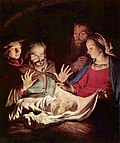Adoration of the Shepherds may refer to several works by the Dutch artist Matthias Stom:
- Adoration of the Shepherds, c. 1640–1645, Museo di Capodimonte, Naples [1]
- Adoration of the Shepherds, now in the Palazzo Madama, Turin [2]
- Adoration of the Shepherds, now in the North Carolina Museum of Art, Raleigh, North Carolina, United States [3]
- Adoration of the Shepherds, now in the Musée d'Arts de Nantes, France [4]
- Turin
- Raleigh
- Nantes


